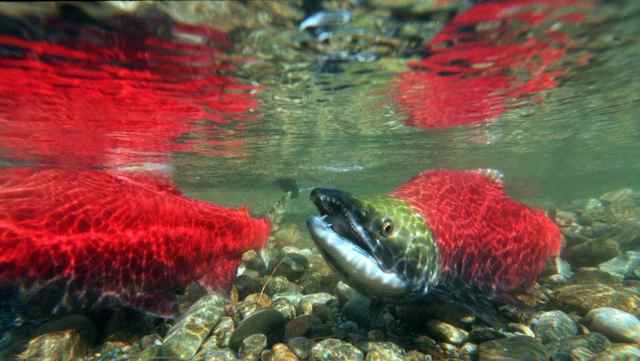forum
library
tutorial
contact

Heat Won't Affect Idaho
Fishing Rules, Biologists Say
by Greg Stahl
Spokesman-Reivew, July 22, 2015
|
the film forum library tutorial contact |

|
Heat Won't Affect Idaho
by Greg Stahl
|
The Columbia River Basin is experiencing a predictable disaster this summer.
 FISHING -- Montana was the first of the Inland Northwest states to enact hoot-owl fishing restrictions to protect trout stressed by unusually low flows and warm water conditions.
FISHING -- Montana was the first of the Inland Northwest states to enact hoot-owl fishing restrictions to protect trout stressed by unusually low flows and warm water conditions.
Oregon and Washington have both enacted emergency fishing rules for some waters that might help in some cases.
The Idaho Fish and Game Department Panhandle Region fisheries manager explained that Idaho had no plans to impose emergency fishing regulations.
Today, Idaho has come out with a longer explanation of the state's reluctance to restrict fisheries. Here it is:
Warm water temperatures came earlier than usual to many of Idaho's fishing waters, but it's unlikely to lead to fishing closures or restrictions similar to those that neighboring states have implemented.While closures in neighboring states won't affect Idaho, Oregon and Washington have implemented restrictions on the Snake River where it shares a border with Idaho."In many streams, what we're seeing this year with water temperatures happens every year, we're just seeing it sooner than normal," said Jim Fredericks, Chief of Idaho Department of Fish and Game's fisheries bureau.
A heat wave in late June and early July spiked water temperatures, but many waters have since cooled to normal summer temperatures. That doesn't mean fish haven't been stressed, particularly trout and other coldwater species, but conditions are not likely to affect fish populations now or in the near future based on current water conditions.
Warm water is a common occurrence during summer, and several factors come into play when it happens. Summer migrations into headwaters, cold tributaries or around underwater springs are a normal part of life for trout in many Idaho rivers. In lakes and reservoirs fish move to deeper, cooler water. Many rivers, or portions of them, have dams that allow water temperatures and flows to be adjusted.
The feeding activity of the fish also helps minimize the problem. Fish that can't find cooler water typically become lethargic and decrease or stop eating, which means slow fishing and a corresponding drop in fishing pressure.
Joe DuPont, Fish and Game's Clearwater Region fisheries manager, said fishing pressure for sturgeon, and catch rates in the Snake River from Idaho anglers, are likely to be low.
"I'm confident the sturgeon in the Hells Canyon reach of the Snake River are not going to be impacted by anglers due to temperatures," DuPont said. "Catch rates drop so much that very few get caught. You can't stress them out if you can't catch them."
The department is monitoring the Snake River, and he noted that during spring, two dead sturgeon were reported by multiple callers to the department.
"When a sturgeon dies, we get repeated calls," Dupont said. "If large numbers were dying, we would know about it."
Fish and Game officials have the authority to implement emergency fishing closures in extreme cases, although they aren't expected.
That's not to say anglers won't see some noticeable effects from warmer. Anglers and others may see localized fish die offs, a few of which have already occurred. Anglers may also notice the effects of stress on individual fish, such as parasites, lesions and other physical signs.
Anglers can also reduce stress on fish by not fishing during the warmest parts of the day, and if they plan to release the fish, land them quickly and carefully release them. If anglers see fish go belly up after being released, they may voluntarily stop fishing until the water cools. Early mornings are typically when the water temperatures are coolest during the day.
The window when temperatures are above a comfortable level for fish are typically short-lived, and most fish can withstand the temporary stress. As water cools, typically in late summer when days get shorter and night temperatures drop, fish resume their normal routines and anglers will likely see catch rates improve.
Related Pages:
Sockeye Arrives at Stanley Despite Warm Water by Associated Press, Teton Valley News, 7/29/15
Salmon Dying by the Thousands in Hot U.S. Rivers by Ted Ranosa, Tech Times, 7/29/15
First Sockeye of Year Returns to Redfish Creek Despite Hot Rivers by Rocky Barker, Spokesman-Reivew, 7/28/15
Why Are Thousands of Migratory Salmon Dying Before They Can Spawn? by Courtney Sherwood, Christian Science Monitor, 7/27/15
Biologists Bring Sockeye into Idaho on Trucks to Get Them Out of Hot Water by Rocky Barker, Spokesman-Reivew, 7/17/15
Sockeye Salmon Suffer Infections in Warm Columbia River System by Rich Landers, Spokesman-Review, 7/17/15
Half of Columbia River Sockeye Salmon Dying Due to Hot Water by Associated Press, The Oregonian, 7/18/15
learn more on topics covered in the film
see the video
read the script
learn the songs
discussion forum
